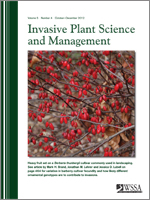We studied the response of naturalized kudzu plants to simulated herbivory at three locations: Delaware (DE), Pennsylvania (PA), and North Carolina (NC). At the DE and PA sites, plant mortality after the first yr was 14 and 50%, respectively, and was highest for plants that had a small starting root crown size. At both sites, 50 and 75% leaf and shoot clipping, and drilling one or two large holes from the root crown into roots, had no effect on aboveground biomass. In NC, all plants survived for 3 yr. Plants subject to 50% vine removal at this site showed significant decrease in aboveground biomass compared to the control, but 50% leaf cutting and root drilling had no effect. In the greenhouse, kudzu seedlings grown in 60 and 100% light compensated for 50% leaf removal, but 75% damage reduced aboveground biomass. Plants survived for 1 to 2 mo in 0% direct light, but only one of 53 plants survived to the end of the experiment. Results suggest that established kudzu plants are able to compensate for biomass removal, seedlings can survive for several weeks without light, and that effective biocontrol might require more than 2 to 3 yr of continuous damage.
Nomenclature: Kudzu, Pueraria montana (Lour.) Merr. var. lobata (Willd.) Maesen & S. M. Almeida
Management Implications: Kudzu is an exotic, invasive weed that covers two to seven million acres in the southern United States. As part of a biological control research program targeting this weed, we clipped leaves, removed or clipped stems, and drilled holes in roots to determine what kind of damage would reduce plant growth and/or survival. Near the edge of kudzu's invasive range (Delaware and Pennsylvania), many plants died following the first year, even where damage treatments were not applied. Near the center of the range (North Carolina), only plants that had half of their vines removed (simulating severe damage by stem-boring beetles) had reduced growth, and none of the plants died. In a greenhouse study, almost all kudzu seedlings grown in complete shade died after 80 d. When leaves were clipped, plants grown under low light conditions were more likely to die than those in full sun. Results suggest that biocontrol alone might not be sufficient to control kudzu, especially near the center of its range. Therefore, field practitioners should consider integrating multiple control tactics to stress the plant, including mechanical and chemical controls, or competition techniques such as planting canopy species with dense foliage. If kudzu patches in full sun are cleared, practitioners should implement additional management techniques such as revegetation to limit the recruitment of new kudzu plants from the seed bank.





